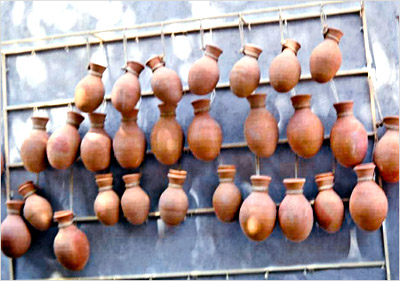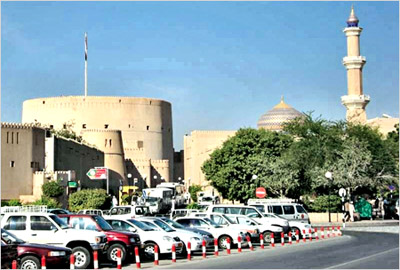Architectural glory
Paradise on desert:
Text and pictures Priyanka Kurugala after a tour of
Oman
|

Indigenous pottery |
The visitors of Nizwa fort must pass a number of Stone Mountain
ranges. The ranges are evident of Oman's beauty and calmness. Nizwa
fort, a massive castle in Nizwa, is located far away from the country
capital, Muscat. This historic building houses many religious and
architectural items which demand the attention of any visitor.
The fort was built around 1650 by the second Ya'rubi Imam, Imam
Sultan Bin Saif Al Ya'rubi. As archives maintain, the fort is the most
visited national monument. It had taken 12 years to complete the whole
structure of the fort. Built above an underground stream, the fort is
symbolic of a town that weathered turbulent periods in Oman's history.
Many historically significant artefacts could be observed inside the
fort. Bedrooms, living rooms, home equipment, carpets, cushions, kitchen
items, mats, carpet and grinding tools are some of them. There are
prayer rooms as well, with handmade design decorations. Artillery have
been installed outside to portray the look of a fort.
The doors are inches thick. The walls are round and strong. They have
been designed to withstand any type of fierce barrages of mortar fire.
The two canons guard the fort's entrance, which opens to a maze of rooms
and many other places. They are high-ceilinged halls, doorways,
terraces, narrow staircases and corridors.
Four cannons on the tower's top once served as the fort's main
firepower - symbolic of the fort's 24-hour protection.
Sri Lankan Ambassador in Oman Ashoka Girihagama commented on the
fort:
"The tower, completed with battlements, turret, secret shafts, false
doors and wells, incorporates a great deal of architectural deception. A
pulley well inside the fort is one classic example. Leather buckets have
been used to draw water from wells."
Access to the top is only through a narrow twisty staircase. This
staircase is a gloomy way to the top. Lights shine through glass-made
steps on which the visitors walk.
Barred by heavy wood, the door is studded with metal spikes. It is to
exhaust the enemy and impede their progress to the top of the building.
Importantly, the fort had been built above a subterranean stream, to
ensure permanent supply of water. Several cisterns, located within the
compound, also ensured the uninterrupted supply of water to the fort.
Sri Lankan Embassy's Attache KAC Kuruppu said the fort was initially
used for military purposes.
“They have used underground cellars to stock food and ammunition. As
archives would suggest, the tower had accommodated 120 guards keeping
watch on the whole countryside. These guards were armed with guns and
flintlocks. About 480 gun equipment had been allowed for a concentrated
barrage of fire if the fort came under attack.”
The visitors could also opt in for traditional items in the gift shop
located within the premises: decorated antique furniture, pottery,
basketry, weavings and jewellery.
 |
 |
| Nizwa from
a distant view |
Various
gift items |
|





